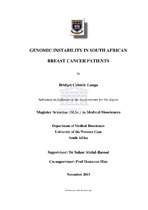| dc.description.abstract | Breast cancer (BC) is one of the most common malignancies in women. Death results from treatment failure and metastatic disease. Thousands of lives might be saved if it was possible to detect and eliminate occult metastatic cells before they become clinically evident. Therefore, there is a critical need to identify new markers to improve treatment options for these patients. Genomic instability is the earliest indication of breast cancer and the use of genomic methodologies is a progress towards early detection and treatment, through the identification of biomarkers that can be translated into novel therapy targets. The interferon regulatory factor-1(IRF-1) gene, localized on chromosome 5q31.1, is believed to act as a tumor suppressor gene in breast cancer. The IRF-1 was found to be inactivated by single nucleotide polymorphism (SNP) in breast cancer suggesting
that the loss of its function might be critical to the development of the disease.
The phosphatidylinositol 3-kinase (PIK3) signaling pathway mediates key cellular
functions and alterations of genes in this pathway, including PIK3CA, serine-threonine protein kinases (AKT1and AKT2), phosphatase and tensin homolog (PTEN), fibroblast growth factor receptor 2 (FGFR2) and ERBB2, whose expression have been demonstrated to be altered in breast cancer patients. In addition, these genes are linked to treatment resistance. vi In this study, we have investigated allelic loss of IRF-1 gene in primary tumors obtained from patients undergoing mastectomy at Groote Schuur hospital (Cape Town, South Africa). These samples were then further analyzed for the DNA copy number changes of specific genes involved in the PIK3/AKT signaling pathway. Statistical analysis has been performed in order to correlate genomic findings with clinical-histopathological and follow up information from the patients and to establish whether these genes can predict prognosis. Our data analysis has indicated that 46 cases (45.5%) out of 101 cases were informative for the IRF-1 dinucleotide marker used for LOH analysis (Figure 3.1). LOH was detected in 23 of these informative cases (23/46; 50%). No statistical significance was found between LOH at the IRF-1 locus and age (≤50 years or >50 years) (P value = 1.0000) and earlier stage (Stages I and II) (P value= 0.4982) based on Fisher’s exact test. Patients presented a high level of DNA copy number changes in genes involved in the PIK3/AKT pathway. The most frequent changes were observed in the PIK3CA and PTEN genes. PIK3CA presented high copy number in 36.8% of the cases. PTEN was
observed with low copy number in 47.5% of the cases. This dissertation shows the effectiveness of genomic methodologies as means for the detection of early breast cancer progression in South African women. The PIK 3/AKT genes can validate the usefulness of breast cancer therapies. | en_US |

